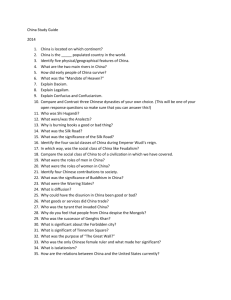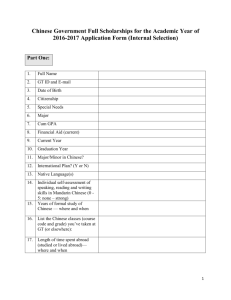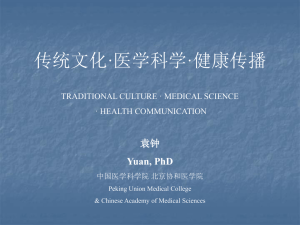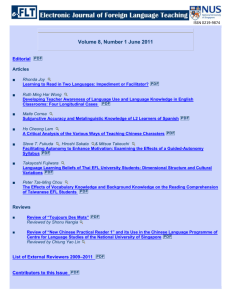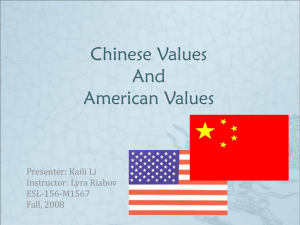Letters from China
advertisement
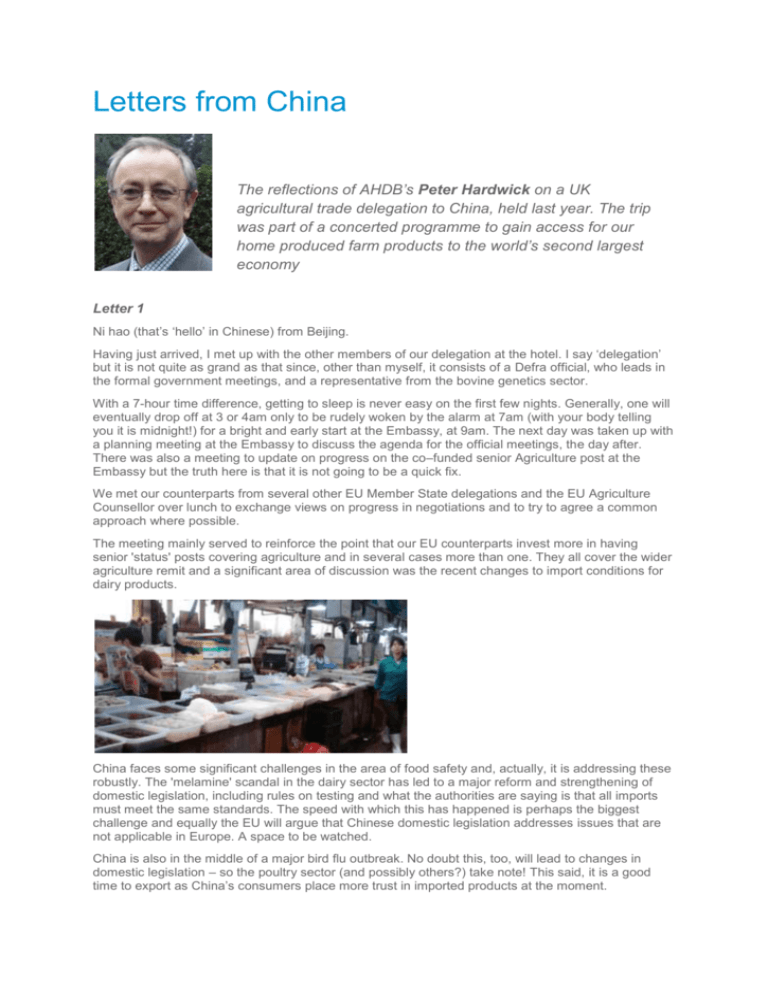
Letters from China The reflections of AHDB’s Peter Hardwick on a UK agricultural trade delegation to China, held last year. The trip was part of a concerted programme to gain access for our home produced farm products to the world’s second largest economy Letter 1 Ni hao (that’s ‘hello’ in Chinese) from Beijing. Having just arrived, I met up with the other members of our delegation at the hotel. I say ‘delegation’ but it is not quite as grand as that since, other than myself, it consists of a Defra official, who leads in the formal government meetings, and a representative from the bovine genetics sector. With a 7-hour time difference, getting to sleep is never easy on the first few nights. Generally, one will eventually drop off at 3 or 4am only to be rudely woken by the alarm at 7am (with your body telling you it is midnight!) for a bright and early start at the Embassy, at 9am. The next day was taken up with a planning meeting at the Embassy to discuss the agenda for the official meetings, the day after. There was also a meeting to update on progress on the co–funded senior Agriculture post at the Embassy but the truth here is that it is not going to be a quick fix. We met our counterparts from several other EU Member State delegations and the EU Agriculture Counsellor over lunch to exchange views on progress in negotiations and to try to agree a common approach where possible. The meeting mainly served to reinforce the point that our EU counterparts invest more in having senior 'status' posts covering agriculture and in several cases more than one. They all cover the wider agriculture remit and a significant area of discussion was the recent changes to import conditions for dairy products. China faces some significant challenges in the area of food safety and, actually, it is addressing these robustly. The 'melamine' scandal in the dairy sector has led to a major reform and strengthening of domestic legislation, including rules on testing and what the authorities are saying is that all imports must meet the same standards. The speed with which this has happened is perhaps the biggest challenge and equally the EU will argue that Chinese domestic legislation addresses issues that are not applicable in Europe. A space to be watched. China is also in the middle of a major bird flu outbreak. No doubt this, too, will lead to changes in domestic legislation – so the poultry sector (and possibly others?) take note! This said, it is a good time to export as China’s consumers place more trust in imported products at the moment. We were back at the Embassy in the afternoon to cover specific issues relating to pig meat import conditions and especially the riveting issue of access for pig trotters. Before anyone accuses me of being flippant, exporters reckon that trotters account for 40% of their trade so gaining access would see exports to China shoot up. More tomorrow on coming face to face with Chinese officials. Zaijian (that’s 'Bye' in Chinese) Peter. Peter Hardwick - Head of Trade Development for AHDB’s beef & lamb and pig divisions. Letter 2: In his second 'letter from China' AHDB’s Peter Hardwick meets his Chinese hosts, gets down to some meaty detail and is rewarded with dinner... plus a chance to try his Mandarin Ni hao. Today was the day of formal meetings with the two Chinese authorities that deal with meat plant approvals (CNCA) and export health certification and import requirements (AQSIQ), as well as the conditions for breeding animals and germplasm (look it up!). These are often protracted affairs as there is a lot of detail to get through but the meetings are conducted in a positive spirit even if there are points of difference. The Chinese departments we deal with are under considerable strain due to the bird flu outbreak so the senior person we were due to see on the meat side was substituted by a more junior person. On the meat side, we still managed to get across the message that our meat production plants have met the Chinese production requirements. All the plants had been inspected to verify these standards and the Chinese inspection team were satisfied. There still needs to be a formal written process but face to face meetings are essential as they underline the importance of the issue. So what happens next is that the plants will be 'registered' to this new standard by China and this will be passed to the inspectors at the ports of entry. So a few more bits of procedure to go. The UK is already successfully exporting live breeding pigs to China but a next step is to agree the export of porcine semen. We had a protracted discussion on the import conditions as some of the requirements are probably not necessary in our case. In fact, there was broad consensus on removing or modifying a good number of these and I would say we are much closer to a workable agreement than previously. We also discussed progress on an agreement for bovine semen exports. The Chinese are interested in improving performance in their dairy industry, in particular, so there is strong commercial demand. The UK has an agreed protocol but negotiations have stalled due to the Schmallenberg (SBV) outbreak in the EU. In fact, the UK has been less affected than other Member States so the route forward for us is to offer to source from bulls which are not carrying antibodies (sero-negative). This is our USP and we have invited Chinese inspectors to come to the UK to visit our facilities and laboratories to see if we can speed up progress. We didn't expect a commitment then and there - that isn't the way here - but this will certainly now be considered and may also offer an opening for an overall look at wider issues in the ruminant sector, including TSE controls. One often comes away from these meetings unsure as to what has been achieved because the process is so lengthy. Yet I know, from speaking to our counterparts in the EU, the US and Canada, that it is the same for everyone; and a sure sign that relations are positive is that we were invited to join our Chinese hosts for dinner immediately after the meeting, at a local restaurant. While in the UK we seem increasingly to be adopting southern European habits and eating later, the Chinese dine early, at 6pm or so - much healthier. I am currently learning Mandarin so the dinner was my first chance to 'road test' my progress and I would score myself a marginal 5 of 10. More effort needed! Zaijian Peter Peter Hardwick - Head of Trade Development for AHDB’s beef & lamb and pig divisions. Letter 3 : In this third letter Peter Hardwick steps back from the grind of international business meetings to reflect on the kaleidoscopic culture of Beijing. Ni hao, The Chinese are rightly proud of their ancient culture and varied cuisine and both are evident in this colourful capital city. Though by no means everything survived the Cultural Revolution, the Imperial Palace complex, known as the Forbidden City, and the Great Wall did. Knowing something about these and having visited them is an essential part of showing respect here as most meetings will start with a few questions about what you have seen and appreciated; saying 'I haven't really had time' or 'I've been too busy working' are seen as pretty feeble excuses and translated as 'I couldn't be bothered'. Conversely, if you have visited and are suitably enthusiastic, this is well received and serves as a good ice breaker. Food, however, is probably the best window into the soul of Chinese people. First and foremost, regardless of the region from which the food comes, the principles of Ying and Yang apply. For example, sugar is often added (in small quantities) to savoury dishes and though sweet and sour pork is a highly westernised dish rarely found in mainland restaurants it demonstrates this principle. This also applies to the other essential elements in addition to taste: Fragrance and colour. For instance, it is usual for green vegetables to be served with some contrasting slivers of red chilli. While rice is ubiquitous in China, its role at formal dinners is limited to a filler. The fine dishes - meat, vegetables, fish, seafood - are served first and rice only served at the end if you are still hungry. Often one is asked if one wants rice at the end of a formal meal and, if not, it is not served at all. Generally, food is served in such a way as to be relatively easy to manage with chopsticks (slippery mushrooms still evade me) but the Chinese use chopsticks with amazing skill to eat everything; tackling a pork rib with chopsticks alone is a real tester. It is also a great source of amusement to the Chinese to watch a clumsy foreigner! The other challenge for the innocent newcomer is to recognise what exactly is in front of you. Fish is easy, often brought in live to show it is fresh before being dispatched. But some of the other items are not so obvious! Almost every part of the animal is eaten and the Chinese firmly believe that each part can endow its own qualities. Pigs’ feet convey energy and movement, for example. The colour of food also brings its own attributes - red dates are seen as good for the blood and there is much crossover between food and traditional Chinese medicine. Food is also consumed in harmony with the four seasons. Spring is the green season but one in which the impurities of winter must be expelled; foods which are deemed to increase oxygen in the body, such as leeks, are consumed. Summer is also a green season but is seen as being damp so green vegetables which release dampness, such as green mung beans, are eaten. Autumn is the yellow season, the time of harvest and yellow foods; foods which provide a store for the winter, such as 'kugua' - bitter gourd - are the order of the day. Winter is a black season and foods like mu'er (tree fungus) egg plant and black beans get on the menu, deemed to protect the body and organs such as the kidney. No account of Beijing would be complete without a comment on the traffic. ‘Appalling’ can be the only word for it. Lane discipline and circumspection appear not to be taught and minor collisions are commonplace. More than minor collisions are also pretty common. The number of cars here is rising and as cars are such a status symbol, everyone wants to drive. Yet taxis are cheap. Fares are charged at the equivalent of 20p per kilometre but, as elsewhere, the time taken is also factored in. All the same, a four mile journey which could easily take half an hour will set you back about £3. I have taken to using the excellent Beijing metro most of the time. Upgraded for the 2008 Olympics, there are more lines, the carriages are air conditioned and a go-anywhere single tariff fare of 2RMb (20p) applies. These, too, get packed at times and with a bit of local knowledge a taxi can be a better bet if you don't fancy feeling like a sardine or, to use the much more elegant Chinese analogy, being 'squeezed into a picture'. Zaijian Peter Peter Hardwick - Head of Trade Development for AHDB’s beef & lamb and pig divisions. Letter 4: As part of his mission to China this week, AHDB’s Peter Hardwick has also been scouting Beijing for dairy export opportunities. Here he serves up some food for thought for our dairy industry Ni hao, The Chinese market for dairy products continues to go from strength to strength and it is not just down to the short term effect of the melamine scandal. This has certainly helped imports gain profile but the simple fact is that average per capita consumption in China is only one third to one quarter of the world average, so growth potential is colossal. Even current demand is way beyond domestic production capacity. I visited the China Dairy Association this week to try to form a picture of the Chinese dairy industry and to see what the opportunities might be. China has some 14.4 million dairy cows but, as with other sectors, it remains fragmented with a few large scale producers but many small scale operations as well. The upshot of this is that, despite the number of cows, dairy production is a relatively modest 37.4 million tonnes. To put it simply, compared with the UK, China produces three times more milk from eight times more cows, while its population is 20 times greater. Only 35% of China’s farms have more than 100 cows, while over 1.8 million farms have between one and four. So the big question is, where does the UK stand on all of this? A quick store check and a visit to an online retailer soon suggested to me there is little UK milk around in China. In fact, the stores I visited had no UK dairy products on the shelves. As far as liquid milk is concerned the limitations of the cold chain mean that most of the milk is UHT and there is a good spread of international suppliers, featuring names from Germany, USA, New Zealand, Australia and France. At two stores I visited, in terms of facings, the biggest presence was German with some imaginative branding, in one case, where a product was branded 'La Irlandesa' – which could be translated as 'the Irish girl’ or ‘maid.’ One to make our Irish friends wince. Incidentally, UHT milk retails at between £1.50 and £1.80 per litre and up to £2.40 a litre for organic milk, with skimmed milk being more expensive than whole milk. Butter came from France, Ireland, New Zealand and cheeses from Italy, France, USA, New Zealand and Australia, with a particularly unappetising range of industrialised cheddars from these last three. I know there is a bit of trade from the UK but it remains marginal and there must be opportunities to grow this. Clearly other EU countries are already making hay under a sun that is going to shine for some time. China is all about relationships and those that have developed these relationships first have an advantage. Indeed, AHDB’s dairy division (DairyCo) recently commissioned a report into Export Opportunities for the UK Dairy Industry and one of the report’s main findings was that the ‘big prize’ opportunity of China would require considerable long term investment in market knowledge and relationship building. With the level of demand as it is, the moment has not yet passed for UK suppliers but we do need to start building our own China connections. As I mentioned, we also visited China's main online retailer, 360buy.com. There is an explosion in online retail and e-commerce in general in China and though 'only' 10% of the Chinese population is currently online, we are still looking at 120 million consumers (this percentage figure was only 6% two years ago). The China Daily reported today that "the annual turnover of China's online shopping industry could hit 1.85 trillion RMB this year (£= 9.4 RMB), an increase of 40% year on year." 360buy.com itself covers around 300 cities, has 50 warehouses and 45,000 staff and a turnover of 70 billion RMB (7.4 billion pounds). The company has its own distribution service and its product range covers just about everything from electronic and white goods to groceries and food. Indeed, the business started in the electronics sector. I met their buyer for imported food. This part of the business bought and imported 158 million RMB's worth of products last year and the aim is to triple this to just under half a billion RMB this year. Imported UHT milk is part of this and again the company currently has no UK suppliers; the only country it buys from within the EU is Germany. The buyer commented quite spontaneously that the company found UK businesses to be unresponsive and slow off the mark, though a visit is planned to the UK later this year to look at import opportunities (including dairy). The China Britain Business Council (the other CBBC) will facilitate and this must be an opportunity for our businesses to expand rather than carry on ‘not taking any wooden nickels’ at home. Zaijian, Peter Peter Hardwick - Head of Trade Development for AHDB’s beef & lamb and pig divisions Letter 5: In the last of his series of letters from China, AHDB’s Peter Hardwick braves a plate of ‘jumping frogs’ in Wǔhàn to share some of the UK’s world class expertise in animal welfare Ni hao, The last leg of my mission to China has taken me to Wǔhàn. Wǔhàn is located in Hubei province on the Yangtze River, where it meets the Han River. Wuhan was made up originally of three cites – Wuchang, Hankou and Hanyang, its name being a combination of these. Incidentally, the Chinese word for Yangtze is Chang Jiang which simply means 'long river'. Wǔhàn has a population of just over 10 million and is one of China's key commercial and transport hubs. It has a sub-tropical climate and a reputation for being one of the hottest places in the country, nicknamed the 'furnace city’. The area seems to have attracted a lot of inward investment from France and nothing illustrates this more starkly than the fact that every taxi is a Citroën – in fact this is where the Citroën joint venture car plant is located. What brought me to Wuhan was the China Animal Husbandry Exhibition, with the UK being an active exporter of livestock genetics, particularly in the pig sector (we also have ambitions to export bovine genetics in the future). The exhibition was preceded by a pig sector conference grandly named the 'Global Pig Forum'; to be fair, with China having over half the world's pigs and over half the world's pork consumers, anything that happens in the Chinese pig sector is going to be global in scale. The conference placed great emphasis on the drive to improve efficiency and, most of all, to address significant consumer confidence issues over food safety. These have affected consumption of domestic product here in the dairy, poultry and pork sectors. Urban Chinese, certainly, see imported products as being safer. Meanwhile, there is strong downward pressure on a domestic market afflicted by the underlying challenges of an uncompetitive pig sector. The conference speakers were very frank and self critical over incidents in China of dead pigs being found in rivers and the need for the industry to improve its image. It was in this context that I was asked to present a paper on animal welfare and, in particular, developments in the UK, which is seen as a world leader on welfare. Our large proportion of outdoor sows and the ending of the use of sow stalls, or 'crates' as the Chinese call them, was of particular interest. Having said that, all of the papers presented on production and efficiency were based on intensive, sow stall systems. The proliferation of companies at the exhibition selling sow stalls was quite an eye opener: Danish, Dutch, German suppliers of sow stalls still have plenty of customers in this part of the world. Nevertheless, my message, that improved welfare can bring wider benefits beyond all the moral issues was well understood, bearing in mind there is an increasingly urbanised population that is now taking a keener interest in how its food is produced. There is still some way to travel in this regard, however. The China Animal Husbandry Exhibition was an excellent showcase for the UK’s major pig genetics companies, several of which have joint ventures in China. With Chinese producers achieving little better than 14 pigs sold per sow per year (the UK average is 23), a combination of our genetics and management techniques could see productivity improve by more than 60%. There were numerous large scale Chinese enterprises at the show looking to source quality UK genetics. It would be remiss of me not to mention the culinary delights of Wuhan before signing off. Being further south the food is spicier, though not as spicy as Sichuan cuisine, a strong influence; the locals’ anaesthetic use of Sichuan peppercorns is notorious. I was persuaded to try a ‘jumping frog’ dish but worry ye not – the frogs were not alive; the ‘jumping’ referred more to one’s reaction after eating it, including desperate calls for water! It was fiery beyond belief and even most of my Chinese companions found it impossible. Visiting a city like Wuhan is an essential part of the China experience. Shanghai and even Beijing, to some extent, have made concessions to foreigners with road signs in Pinyin (latin script), translated menus and shop signs in Chinese and English. Yet outside these major centres you are in deep China, where you get a much stronger impression of the national character. These cities are at least as intense in terms of hustle and bustle and execrable traffic. Their people are driven to succeed, they love business and there is an underlying optimism despite the recent economic slowdown. We all have to hope this positive thinking is well founded since our own ambitions to develop exports to this huge potential market will depend on it. Zaijian. Peter Peter Hardwick - Head of Trade Development for AHDB’s beef & lamb and pig divisions

